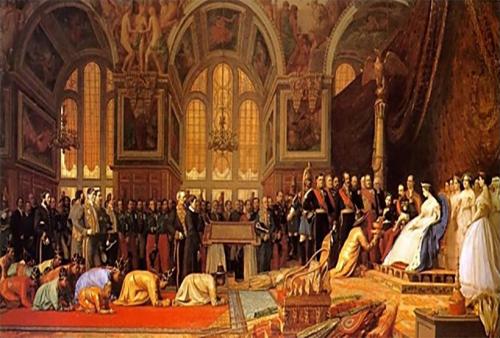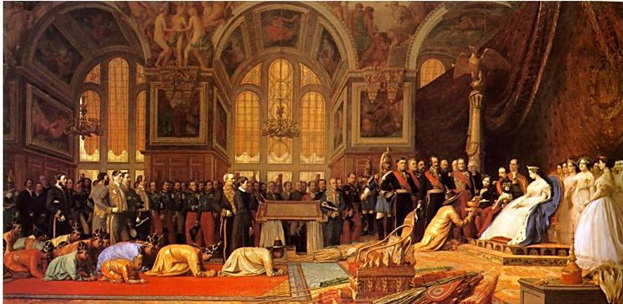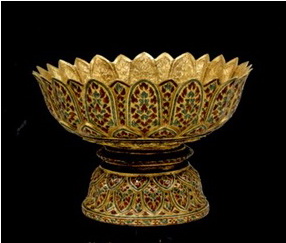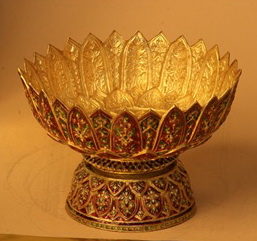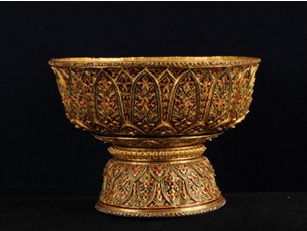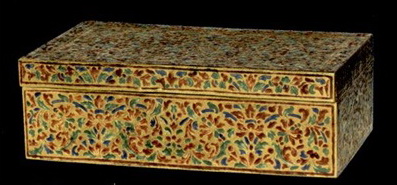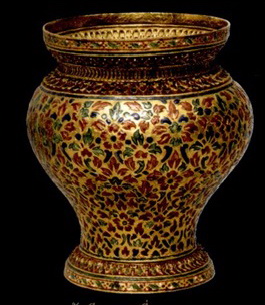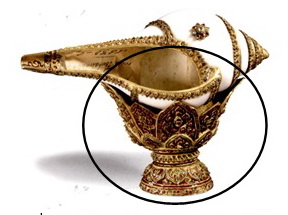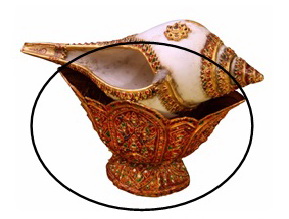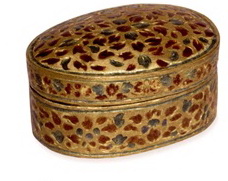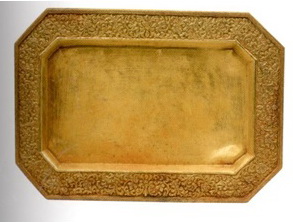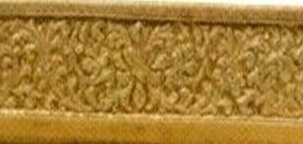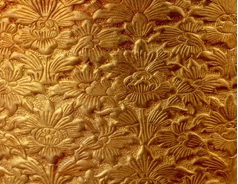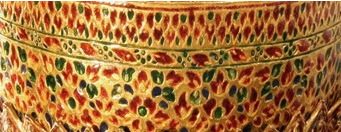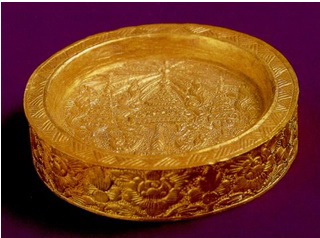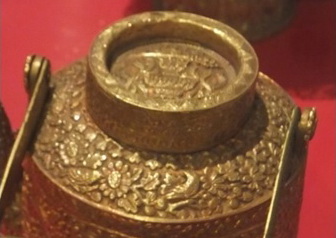Comparing Characteristics of the Royal Golden Paraphernalia Bestowed upon Napoleon III, Emperor of France to Regalia Displayed in the Pavilion of Regalia, Royal Decorations and Coins, at the Grand Palace of Thailand
translated by Suwara Sakornsawat
Picture 1 : A picture of Napoleon III, Emperor of France receiving the Siam ambassadors in the ballroom at the Palace of Fontainebleu, France.
Cultivating friendly relationships with many other countries in Europe were the main royal policies for foreign affairs in the Kingdom of Siam. The important objectives were to modernize Siam and avoid problems with the superpowers that had previously saved Siam’s sovereignty. During the reign of King Rama IV some countries tried to occupy Siam, so the king cultivated close relationships with some powerful countries to hold the balance of power and to save Siam from being colonised. King Rama IV sent Siamese ambassadors to European countries, for example, England in 1857 and France in 1861. According to King Rama IV’s intention, he revived French-Thai relations after they had started and come to an end during the reign of King Narai in the Ayudhya period. Additionally, he was familiar with the French people coming to Siam for trading purposes. As a result, he decided to send Siamese ambassadors to France to give Napoleon III, the Emperor of France and his consort Empress Eugenic, a royal letter and paraphernalia which was presented to them at the Palace of Fontainebleau on June 27, 1861. In this regard, the French-Thai relationship, is notable diplomatic history for both countries.

Picture 2 : The royal tributes displayed in a glass cabinet in the Chinese room at the Palace of Fontainebleu, France.
Picture 3 : The Place at Fontainebleu, a place for displaying royal tributes.
The royal tributes were ordered by Empress Eugenic to be displayed in the Chinese room at the Palace of Fontainebleau. Currently, they are all kept together with the Chinese royal paraphernalia, displayed in a glass cabinet without any captions (Picture 2 and 3). The royal tributes sent to Emperor Napoleon III are similar to the golden royal paraphernalia for high-ranking members of the royal family also currently displayed in the Pavilion of Regalia, Royal Decorations and Coins at the Grand Palace. The royal tributes represent not only the relationships between France and Siam but also the craftsmanship, preferences and unique qualities representing the civilization of Siam. The characteristics of the royal objects indicate the talents of the royal goldsmiths at that time. Comparing characteristics of the royal golden paraphernalia from France to regalia displayed in the Pavilion of Regalia, Royal Decorations and Coins at the Grand Palace of Thailand, it is found that both are similar in shape, design and technique.
Characteristics of the Royal Golden Paraphernalia used as Royal Tributes
The royal golden paraphernalia bestowed upon Emperor Napoleon III as royal tributes from King Rama IV are made from valuable materials and enameled with beautiful colours. They show the skills and elaboration of the royal goldsmiths. Their characteristics are similar to the royal golden paraphernalia displayed at the Pavilion of Regalia, Royal Decorations and Coins in terms of shape, technique and design.
1. Shape
Some royal paraphernalia are the same shape as many regalia displayed in the Pavilion of Regalia, Royal Decorations and Coins. They are as follows:
1) The lotus-shaped pedestal tray with the enameled-gold petals of (Picture 4) are similar to the enameled-gold pedestal tray used for washing the face displayed in the Pavilion of Regalia, Royal Decoration and Coins (Picture 5).
Picture 4 : The enameled-gold petal of lotus-shaped pedestal tray in the Palace of
Picture 5 : The enameled-gold pedestal tray for washing the face in the Pavilion of Regalia, Royal Decorations and Coins.
2) The enameled-gold water bowl for washing the face (Picture 6) is similar to the one displayed in the Pavilion of Regalia, Royal Decoration and Coins (Picture 7).
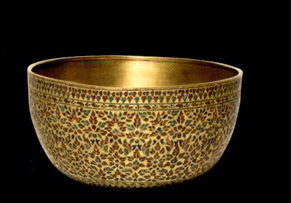
Picture 6 : The enameled-gold water bowl for washing the face at the Palace of Fontainebleu, France.
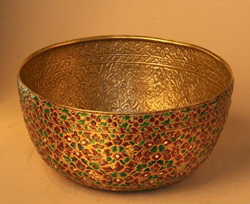
Picture 7 : The enameled-gold water bowl for washing the face at the Pavilion of Regalia, Royal Decorations and Coins.
3) The enameled-gold pedestal tray for washing the face (Picture 8) is similar to the pedestal trays used as royal paraphernalia displayed in the Pavilion of Regalia, Royal Decoration and Coins (Picture 9).
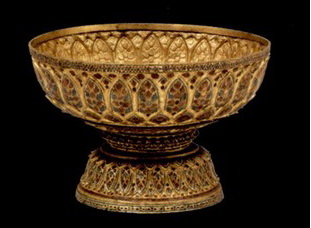
Picture 8 : The enameled-gold pedestal tray for washing the face in the Palace of Fontainebleu, France.
Picture 9 : The enameled-gold pedestal tray for washing the face in the Pavilion of Regalia, Royal Decorations and Coins.
4) The enameled-gold betel-nut case (Picture 10) is rectangular in shape which is similar to the one studded with diamonds and engraved with the Chulamongkut (coronet) displayed in the Pavilion of Regalia, Royal Decoration and Coins (Picture 11).
Picture 10 : The enameled-gold betel-nut case at the Palace of Fontainebleu, France.
Picture 11 : The enameled-gold betel-nut case studded with diamonds and engraved with the Chulamongkut (coronet) in the Pavilion of Regalia, Royal Decorations and Coins.
5) The enameled-gold spittoon (Picture 12) is similar to the one displayed in the Pavilion of Regalia, Royal Decoration and Coins (Picture 13).
Picture 12 : The enameled-gold spittoon at the Palace of Fontainebleu, France.
Picture 13 : The spittoon at the Pavilion of Regalia, Royal Decorations and Coins.
6) The enameled-gold long-necked water pitcher (Picture 14) is used for a cool water vessel. It is similar to the one displayed in the Pavilion of Regalia, Royal Decoration and Coins (Picture 15).
Picture 14 : The enameled-gold long-necked water pitcher at the Palace of Fontainebleu, France.
Picture 15 : The enameled-gold long-necked water pitcher for male royals at the Pavilion of Regalia, Royal Decorations and Coins.
7) The enameled-gold pedestal tray (Mungsee) (Picture 16) is a vessel with a conch shell attached to it and is part of a betel-nut set for male royals. Its rim is cut sharply like a petal of a lotus flower. It is similar to the one displayed in the Pavilion of Regalia, Royal Decoration and Coins (Picture 17).
Picture 16 : The enameled-gold pedestal tray (Mungsee) at the Palace of Fontainebleu, France.
Picture 17 : The enameled-gold pedestal tray (Mungsee) at the Pavilion of Regalia, Royal Recorations and Coins.
8) The enameled-gold oval box (Picture 18) is a small box and its cover is made from enameled gold. It is similar to the one displayed in the Pavilion of Regalia, Royal Decoration and Coins (Picture 19).
Picture 18 : The enameled-gold oval box at the Palace of Fontainebleu, France.
Picture 19 : The enameled-gold oval box at the Pavilion of Regalia, Royal Decorations and Coins.
9) The engraved golden tray (Picture 20) is used with a tea set. It is similar to the one displayed in the Pavilion of Regalia, Royal Decoration and Coins (Picture 21).
Picture 20 : The engraved golden tray at the Palace of Fontainebleu, France.
Picture 21 : The engraved golden tray for a tea set at the Pavilion of Regalia, Royal Decorations and Coins.
To summarize, the royal golden paraphernalia used as royal tributes at the Palace of Fontainebleau and some royal golden paraphernalia, which were made in the reign of King Rama IV and displayed in at the Pavilion of Regalia, Royal Decorations and Coins at the Grand Palace are similar in shape.
2. Technique
Techniques used in the making of the royal paraphernalia offered to Emperor Napoleon III and the royal paraphernalia displayed in the Pavilion of Regalia, Royal Decoration and Coins are the same. These are the techniques of molding and decoration.
2.1 Technique of molding
Both sets of paraphernalia are made using the same molding techniques. First, Gold leaves are melted, spread out and ironed respectively. Second, they are shaped and joining metals surfaces are soldered. Lastly, The surfaces are decorated by engraving or enameling. The royal paraphernalia excavated at Kru, a hiding place found in the Stupa of a temple, in the Mahathat Temple and the Ratburana Temple dating from the early Ayudhya period indicate this technique at that time.
2.2 Techniques of Decorating
There are 3 techniques of decorating as follows:
1) Technique of Engraving and Enameling (Picture 22) Although it is hard to find royal paraphenarlia with this technique, it has been used to decorate every kind of the golden royal paraphernalia from every reign, especially the royal regalia for high-ranking royals displayed in the Pavilion of Regalia, Royal Decorations and Coins. The technique makes lined patterns and enameled areas more vivid.
Picture 22 : Techniques for engraving and enameling with a pedicels and leaves design.
2) Technique of Embossing (Picture 23) Like the previous technique, it is popular for decorating the royal regalia of lower ranked royals and noblemen for ones who are granted carved and enameled gold. This technique is especially used for hot food or hot water containers, for example engraved golden footed trays and engraved golden saucers.
Picture 23 : Technique of embossing.
3) Technique of Engraving and Enameling of the Engraved Areas (Picture 24) Generally, it is used to decorate the royal golden paraphernalia used as royal tributes. It is assumed that this technique first appeared in the reign of King Rama IV because there isn't any clear evidence before this time. This step is similar to making nielloware.Noticeably, the royal golden paraphernalia, for example the enameled-gold water bowl for washing the face, displayed in the Pavilion of Regalia, Royal Decorations and Coins uses the same technique as the royal tributes. It is possible that this technique has used for the royal golden paraphernalia since the reign of King Rama IV.
Picture 24 : Technique of engraving and enameling the engraved areas.
It can be concluded that both royal tributes and royal golden paraphernalia displayed in the Pavilion of Regalia, Royal Decorations and Coins were decorated using the same technique.
3. Designs
Some of the designs incorporated in the royal paraphernalia offered to Emperor Napoleon III and some of the royal paraphernalia displayed in the Pavilion of Regalia, Royal Decoration and Coins are the same. The designs are as follows:
3.1 Hibiscus design It is a basic Thai design which is popular for decorating most royal golden paraphernalia used as royal tributes and many other golden paraphernalia displayed in the Pavilion of Regalia, Royal Decorations and Coins. The hibiscus design is a symbol of luck, wealth and prestige from ancient Thai beliefs and is popular for decorating royal golden paraphernalia. Evidence about hibiscus designs was found at Kru in the Ratburana temple dating from the Ayudhya period. Right up to the reign of King Rama IV, the golden cylinder-shaped teapot with an engraving of a radiant royal coronet (the seal of King Rama IV) on the lid, displayed in the Pavilion of Regalia, Royal Decorations and Coins, was decorated with the hibiscus design. It shows that the hibiscus design was popular from the Ayudhya to King Rama IV periods.
The royal golden paraphernalia used as royal tributes incorporate engraving and enameling techniques and decorated with a hibiscus (Picture 25), while the golden royal paraphernalia made in the reign of King Rama IV and later, displayed in the Pavilion of Regalia, Royal Decorations and Coins, incorporate embossing techniques and decorated with a hibiscus design (Picture 26). Comparing their techniques and designs, both are the same design but are different in technique. The technique and design of an enameled-gold water bowl for washing the face (Picture 27) displayed in the Pavilion of Regalia, Royal Decorations and Coins and the technique and design of a door panel, which was used in the reign of King Rama IV, at Ubosot in the Boromnivas temple (Picture 28) are the same. Therefore, it is possible that these characteristics have existed since the reign of King Rama IV.
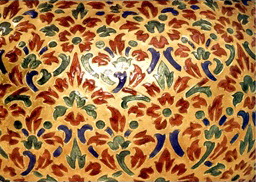
Picture 25 : Hibiscus design with technique for engraving and enameling the engraved areas of royal tributes during the reign of King Rama IV.
Picture 26 : Hibiscus design with technique of embossing the royal paraphernalia at the Pavilion of Regalia, Royal Decorations and Coins.
Picture 27 : Hibiscus design with technique of engraving and enameling the engraved areas of royal paraphernalia at the Pavilion of Regalia, Royal Decorations and Coins.
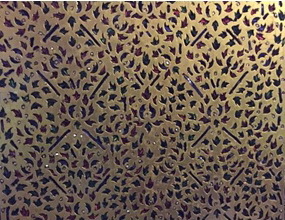
Picture 28 : Hibiscus and its leaves design with technique of engraving on a door panel, at the Boromnivas temple.
3.2 Pedicels and Leaves Design It is a design which look like petals. Most petals on lotus-shaped pedestal trays are decorated with this design. Not only does it appear on royal golden paraphernalia used as royal tributes, for example an enameled-gold pedestal tray (Mangsee) and an enameled-gold oval box but it also appears on many royal regalia displayed in the Pavilion of Regalia, Royal Decorations and Coins.
3.3 Other Designs There are other designs decorated on royal golden paraphernalia used as royal tributes and royal regalia displayed in the Pavilion of Regalia, Royal Decorations and Coins, for example, the botanic pattern design on the rims of carved gold trays and the floral decoration of interlocked flower design on the enameled-gold square box. These designs can be seen from every reign.
The royal paraphernalia’s designs from both museums are the same and related together. Designs of the royal tributes send to France not only show the craftsmanship at that time but also estimates the age of valuable treasures displayed in the Pavilion of Regalia, Royal Decorations and Coins.
Relevant Characteristics between the Royal Golden Paraphernalia used as Royal Tributes and Regalia in the Pavilion of Regalia, Royal Decorations and Coins
There are no traces of the making of most golden royal paraphernalia displayed in the Pavilion of Regalia, Royal Decorations and Coins, So it is almost impossible to indicate each of their particular periods clearly. However, the royal seal engraved on their surfaces can help answer their ages and help identify the period of time of other relevant royal objects. In the reign of King Rama IV, there are 2 royal seals; the Chulamongkut of King Rama the IV and the Chutamani of King Pinklao (Picture 31), the younger brother of King Rama IV.
Apart from the royal golden paraphernalia sent to France by King RamaIV, by Siamese Ambassadors, to Emporer Napoleon III of France, Royal golden paraphernalia was also Queen Victoria of Great Britain (Picture 29). These royal golden paraphernalia may have only been made and used the royal tributes by the royal goldsmiths during the reign of King Rama IV. The royal tributes and the royal golden paraphernalia are similar in characteristics. Besides, the royal tributes and the royal regalia for the king or high-ranking royals in Siam are of equal status. The royal regalia displayed in the Pavilion of Regalia, Royal Decorations and Coins are thought to be contemporary in design with the royal tributes sent to France in the reign of King Rama IV, for example, the enameled-gold water bowl for washing the face and the enameled-gold oval box.
The royal tributes displayed in the Palace of Fontainebleau are important evidence showing the relationships between France and the Kingdom of Siam as well as showing traditional Thai crafts during the reign of King Rama IV. The golden royal paraphernalia bestowed upon Emporer Napoleon III and Queen Victoria is assumed to be made as royal tributes only. According to further examinations, the royal tributes sent to France and England including other royal regalia displayed in the Pavilion of Regalia, Royal Decorations and Coins are the same in shape, technique and design. Moreover, comparisons within the three groups of royal paraphernalia are the key to answer some of the unknown characteristics and periods of time for some of the royal golden paraphernalia displayed in the Pavilion of Regalia, Royal Decorations and Coins.

Picture 29 : The royal tributes bestowed upon Queen Victoria of Great Britain (source : Office of Literature and History, Fine Art Department. (2013). Press comment on the Siamese embassy to England (1857-1858). Bangkok: Fine Art Department.
Picture 30 : An engraving of the Chulamongkut (the seal of King Rama IV) on the lid of a cylinder-shaped teapot displayed in the Pavilion of Regalia, Royal Decorations and Coins.
Picture 31 : An engraving of the Chutamanee (the seal of King Pinklao) on the lid of a cylinder-shaped teapot displayed at the Pavilion of Regalia, Royal Decorations and Coins.
Somsak Ritpakdee.(2015). "Comparing Characteristics of the Royal Golden Paraphernalia Bestowed upon Napoleon III, Emperor of France to Regalia Displayed in the Pavilion of Regalia, Royal Decorations and Coins, at the Grand Palace of Thailand". (Thai version) Retrieved January, 2015, from Pavilion of Ragalia, Royal Decorations and Coins e-museum: http://emuseum.treasury.go.th
